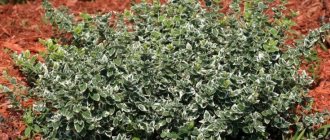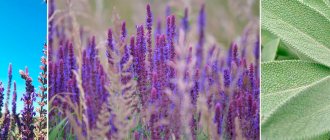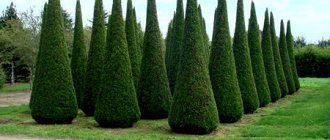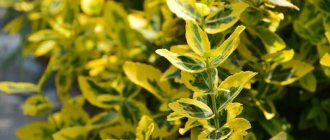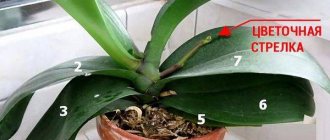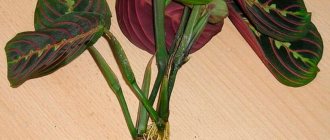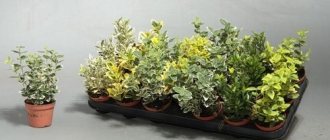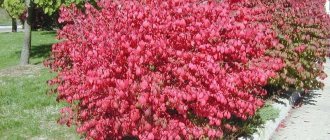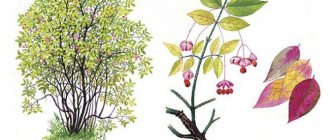Description and features of Fortune's euonymus
This is an evergreen deciduous plant that can develop in climatic conditions that are harsh for shrubs of this species, when the air temperature drops to -25°C.
The structural features of the plant help it survive frosts in winter. Its numerous shoots spread above the surface of the earth and are covered with a cap of snow, which protects the bush from freezing.
Lat. Euonymus fortunei 'Sunspot'
The plant has leathery leaves reaching 4 cm in length with uneven and slightly curved edges. The color of the leaves of decorative forms of shrubs varies:
- "Emerald Gaiety" - green with a white border in summer, raspberry pink in winter;
- "Minimus" - dark green all seasons;
- "Variegatus" - green with a white border in summer, pale pink with a light green center in winter;
- "Sunspot" - dark green with a yellow center all seasons;
- 'Emerald Gold' has green leaves with a bright yellow edge that turns pink in winter;
- "Coloratus" - dark green leaves in summer turn crimson in winter.
This variety of color shades is united by the glossy shine characteristic of the leaves of the described plant.
The homeland of the bush is China. The plant has become widely known among gardeners since 1907, when it began to be cultivated in the Black Sea region and in Ukraine. The evergreen shrub rarely reaches 60 cm in height; its long side shoots, growing up to 3 m, make it especially decorative.
They tend to cling to any support and form rooting nodes.
All forms of euonymus have inconspicuous and small flowers of pale green color, collected in inflorescences of 3-5 pieces. The decorative value of the shrub is given by the fruits, during the ripening of which the plant is transformed. The fruits are four-part capsules, inside which there are numerous seeds, covered with a fleshy aneurysm.
At the beginning of formation, the boxes are pale green in color, and during full ripening they acquire bright shades from dark purple to soft pink. Such bright colors enliven the garden plot in September, when many plants wither and lose their attractiveness.
The toxicity of the bush has been greatly exaggerated. Euonymus contains alkaloids in small quantities; poisoning of an adult occurs when eating at least 30-35 berries of the bush.
Expert opinion
Yulia Yurievna
I have a large garden and vegetable garden, several greenhouses. I love modern methods of cultivating plants and mulching the soil, and I share my experience.
Ask a Question
Let's take a closer look at the euonymus fortunei variety to evaluate the full range of possibilities for decorating a site. It is important to study not only the color of the crown, but also the size, shape of the leaves and requirements for growing conditions and care. Vegetus are small low shrubs that have rich green, dark leaves, matte and oval. The veins on the foliage are light, often white. The plant develops quickly, filling the area allotted to it. If on the path of such a bush there is a stone or other plant, it can entwine it. Minimus - differs not only in the dark color of the crown. This is a miniature plant, the leaves are elliptical and the branches are very thin. It is resistant to cold and requires little maintenance. Emerald Gold - plants develop rather slowly and are not large. The height of an adult specimen, as a rule, is no more than 25-30 centimeters. The border is not only yellow, but golden. The foliage is pointed. The leaf dimensions do not exceed 2 centimeters. Emerald Gaiety - small plants, reaching a height of 20-25 centimeters. The leaves are oval and have an uneven edge. Emerald Gaiety is often used in landscape design. Disadvantages include instability to severe frosts. In cold regions, shelter is required. Silver Queen are large shrubs that grow quickly. The leaves have a rich green color. The border is white. When the temperature drops, the white color on the leaves changes to pink. SunSpot is a short variety. Has a dense crown. The leaves are oval. A distinctive feature is resistance to frost.
General botanical description
The description was first given by the English scientist, gardener and botanist Robert Fortune, after whom the shrub was named.
This is a ground cover plant that does not shed its leaves in the winter. Due to its highly decorative properties, it is actively used in landscape design. It is also rapidly gaining popularity because it is highly frost-resistant. Although it loves sunlight, it tolerates partial shade well. Grows for a long time without watering in hot weather. Easy to care for.
Latin name: Euonymus fortunei.
The average height of Fortune's euonymus is 0.3 m. The crown diameter is 0.5 m and more. However, these parameters largely depend on the variety and age of the plant. This can be seen in the comparison table:
Leaves:
- do not fly around for the winter;
- oval-ellipsoidal;
- with a pointed top and jagged edges;
- leathery and dense;
- on a dark green, emerald background, whitish-yellow spots, dots, veins, inclusions stand out;
- in some varieties they turn pinkish or reddish in autumn.
Escapes:
- creeping;
- upon contact with the soil, they form nodular roots that cling to the foundation;
- As a result, they grow shallowly into the ground or rising up the supports.
Flowers:
- small;
- inconspicuous, lost in the foliage;
- whitish-yellow, olive color;
- flowering period - from mid-May to June, some varieties may be out of schedule;
- It does not bloom in central Russia.
Fruit:
- greenish, with a whitish tint (in rare varieties - red);
- smooth;
- elastic;
- look like balls with a diameter of 3-4 cm;
- ripen in August-September, remain on the bush until late autumn or even throughout the winter, but not in central Russia;
- contain poisonous toxins that can cause poisoning.
The territorial homeland of Fortune's euonymus is China. In its natural habitat it can be found in undergrowth, valleys and floodplains. In nature, the height of the bush can reach 3 m.
Euonymus Fortune - planting and care
Planting shrubs
Euonymus in open ground
When choosing a planting site, you need to take into account that the decorative appearance of the leaves is achieved through active photosynthesis, and this is only possible in well-lit areas.
But it is better to avoid keeping the bush in direct sunlight for a long time. This leads to yellowing of the green color and the appearance of painful spots on the leaves.
The optimal place for plant development is where the sun's rays fall in the first half of the day or in the evening - partial shade.
To grow a beautiful plant, it is better to purchase a three-year-old seedling at a garden center. When choosing a seedling, you need to pay attention to the integrity of the roots.
In a healthy plant they are free of microcracks, growths and signs of rotting. It is better to plant seedlings in the spring, when the soil has warmed up and a stable temperature has established. The favorable period for this is from April 20 to May 10.
The plant grows well in moisture-intensive and aerated soils, the acidity of which is close to neutral. You can prepare a good substrate for shrubs yourself; to do this you need to mix:
- leaf soil 50%,
- humus 30%,
- turf soil 10%,
- sand 10%.
At the chosen location you need to form a hole, the size of which is two times larger than the rhizome of the seedling. The bottom of the hole is compacted so that there are no air pockets left. At the bottom of the hole you need to lay a drainage layer, filling it ¼ with expanded clay or pebbles.
The seedling is placed in the prepared hole and sprinkled with substrate. To make the roots fit more tightly during the process, the stem needs to be slightly shaken.
The transition line between the stem and the root should remain at ground level. Deepening of the root collar often leads to rotting. And insufficient immersion of the seedling in the soil will result in drying out of the root system.
After planting, the young shrub is watered abundantly and covered with a thin layer of soil.
Care
The shrub requires moderate but abundant watering. If the summer is not rainy, you need to water 4-6 times during the season, moistening the soil to a depth of 40 cm. The water requirement for an adult plant is 30 liters per 1 m2. If autumn is dry, you need to provide the shrub with a supply of water for the winter by watering it in the second half of October.
Young bush of Fortune's euonymus (photo)
To protect against drying out of the soil and the active development of weeds, a layer of mulch is made. To do this, the circle around the trunk is sprinkled with a 5 cm layer of peat, sawdust or nutshells. It is necessary to loosen only as a dense crust forms on the surface of the soil.
Fortune's euonymus is a plant responsive to fertilizers. In the spring, the soil under the bush is spilled with organic matter; for this you can select and dilute in water:
- manure 1: 8;
- bird droppings 1: 20;
- bone meal 1:20.
The optimal rate for one bush is 10 liters.
Before the euonymus blooms, it needs to be fed again. Potassium salt (10 g) and superphosphate (30 g) are added to the circle around the trunk.
Mechanical injury to plant tissue takes a lot of energy for self-healing. Therefore, it will be better for the shrub if pruning is done in the spring before the buds open. During the process, weak, damaged and old branches are completely removed. The cut areas should be lubricated with garden varnish made from tree resin (400 g) and linseed oil (40 ml).
Young shrubs up to 3 years old need to be covered before winter; straw or spruce branches are used for this. The trunk circle of adult plants is mulched with sawdust or peat.
Advantages and disadvantages of using euonymus in landscape design
The main treasure of the euonymus is its stunningly beautiful foliage, which in the fall does not lose its attractive appearance like other plants, but is painted in a beautiful range from pinkish and crimson to dark purple.
Why is euonymus so popular:
- grows quickly, has a significant crown growth in one growing season;
- tolerates frost well, is hardy, does not require frequent watering;
- tolerates cutting and shaping well, begins to actively branch;
- adapts to different types of soil, grows in gardens around the world;
- attracts pests of fruit trees, taking the blow;
- creeping varieties are suitable for vertical gardening.
The disadvantage of using euonymus in landscaping is the toxicity of its beautiful fruits. They taste sour at first, then bitterness and signs of poisoning appear. Fifty berries are enough to pose a serious threat to health and life. Therefore, euonymus is not planted in places where there is a large presence of children.
The excellent tolerance of beresklit to “haircuts” allows you to form real “rock gardens” from plants
Pests and diseases of shrubs
Occasionally, when large colonies of aphids and spider mites appear on a personal plot, damage to the euonymus can be observed. To combat them, folk remedies are used:
- onion peel (100 g) is infused in water (3 l) for two days;
- dry mustard (20 g) is infused in water (1 l) for two days;
- Calendula flowers (0.5 kg) are filled with water (5 l) and infused for three days.
View of healthy euonymus leaves (photo)
Before using folk remedies, for better adhesion to the plant, laundry soap is added to the composition at the rate of 40 g per 10 liters. Treatment is carried out once a week. In case of severe damage, the chemical drug “Actellik” is used.
When mealybugs appear, a two-stage treatment with the preparations “Confidorm”, “Aktara”, “Fitoverm” will be required with a break of 10 days.
The most common disease of this plant is trunk rot. This is a fungal infection that almost always leads to the death of the plant. A preventative measure against the appearance of rot is treatment with a solution of Bordeaux mixture at the end of the spring season and removal of the affected areas of the bush.
Another fungal disease dangerous for euonymus is powdery mildew. Increased dampness, a large amount of nitrogen in the soil and thickening of plantings contribute to the appearance of mealymeat fungus spores.
When a characteristic white coating appears on the leaves of the euonymus, you need to treat the plant with an antifungal agent. Popular drugs:
- "Skor"
- "Topaz",
- "Vikaros"
- "Fundazol".
Depending on the chosen product and the degree of damage, treatment is carried out 2-4 times with an interval of 10 days.
If all growing rules and preventive measures are followed, diseases and pests do not cause any particular concern for the gardener. To minimize the risk of damage, it is important to follow the watering regime, avoiding the formation of excessive dampness and keeping the number of pests in the entire garden plot under control.
Varieties
Distinguished by the diversity of Fortune's euonymus varieties, gardeners can choose the one that fits perfectly into the landscape design of the site.
- Emerald Gold (Emerald Gold) - Golden emerald
Height - 0.3 m. Color: rich emerald or dark olive with golden lemon or yellowish edging, in autumn - bright pink or reddish. The berries are burgundy in color. It has the longest growing season, which can last 5 years.
- Emerald Gaiety (Emerald Haiti) - Emerald Joy
Height - 0.2 m. Color: emerald with a clear white border, pinkish in autumn. Looks good for decorating rabatkas.
- Silver Queen (Silver Queen) - Silver Queen
Height - 0.7 m. Color: bright green with white edging, pink in autumn. A liana-forming plant, often used to decorate a stand or trellis. Fast growing variety. Doesn't bloom or bear fruit.
- Interbolwi (Interbolwi)
Height - 0.3 m. Color: dark green with a large expressive yellowish-whitish spot in the center. It is usually used to form borders and fill empty spaces on the site. Creates a dense yellow-green carpet. Resistant to frost, diseases and pests.
- Blondy
It is distinguished by its rapid growth rate. Height - 0.6 m. Likes to climb up supports, so it is often used in vertical landscaping areas. Color: rich green with a large yellowish-white spot in the center.
- Coloratus (Coloratus) - Variegated
Height - 0.4 cm. Crown diameter - 4 times larger: up to 1.5 m. Color: rich emerald, purple in autumn. One of the most frost-resistant varieties of euonymus Fortune.
- Sunspot (Sunspot) - Sunny Bunny
Height - 0.25 m. Length of shoots - 1.2 m. Squat, compact, spherical shrub. Doesn't grow much. Color: large yellow-lemon spot in the middle of the leaf on a green background. Requires shelter for the winter.
- Variegatus (Variegata/Variegatus) - Multi-colored
Height - 0.3 m. Color - green with white edging; color remains in autumn.
- Harlequin (Harlequin) - Harlequin
Height - 0.25 m. Leaf color: on a white-green background - pinkish, yellowish and creamy inclusions. A distinctive feature is the shoots are white. Prefers to grow in shaded places.
- Golden Harlequin (Golden Harlequin) - Golden Harlequin
Not much different from the previous variety. A little higher and the shade of the foliage is brighter. Height - 0.4 m. Color: a mixture of green, yellow-golden, white and cream, a slight pinkish color appears in autumn. A distinctive feature is that the flowers have a beautiful blue tint. No other variety has this effect.
- Vegetus (Vegetus)
It has a high growth rate and easily entwines supports. It looks like a thick carpet. Color of matte leaves: dark green with a large number of whitish veins; color remains in autumn and winter.
- Minimus (Minimus) - Baby
Dwarf variety. Miniature compact bushes no more than 20 cm high. Leaves in the form of small medallions with a diameter of only 1 cm. In color - a mini copy of the above-described Vegatus variety. It grows slowly. Used in alpine slides and rockeries. Does not tolerate waterlogging.
- Canadale Gold
Height - 0.8 m. Compact shrub. The color is green with a yellow border; the color remains the same in autumn and winter.
Methods for propagating Fortune's euonymus
There are a lot of methods of reproduction, so it’s worth considering them all.
Cuttings
Euonymus grown from cuttings (photo)
Good root-forming ability allows euonymus to be propagated by cuttings. Favorable times for this are the second half of June and July. For cutting cuttings, select semi-woody shoots from bushes that are at least 5 years old. A good planting material is a cutting 8-10 cm long with 1-2 internodes.
It is not recommended to cut shoots under the scorching sun, which promotes the evaporation of moisture from the cuttings.
The upper cut is made perpendicular to the kidney. The lower one is at an angle below the kidney. The cut of the cutting is lubricated with a root former; for this you can use the drug “Kornevin”.
The cuttings are planted in special boxes filled with a mixture of peat and sand and covered with film.
The optimal temperature for rooting is +20-+25°C. A full-fledged root is formed in 45-50 days. Before this, the cuttings should be provided with moderate watering.
Seeds
The fruits of the bush for seed propagation are collected in September. The fact that they are ripe is indicated by cracking of the capsule and darkening of the seeds. In autumn, they are planted immediately after harvest, having removed the pre-seeds in advance.
For spring planting, stratification will be required. To do this, the seeds are placed in plastic containers, laid out on a damp cloth, and placed in the refrigerator.
Seeds for seedlings are planted in early March in a substrate similar in chemical composition to the one in which the shrub will develop in the open air.
By layering
For this method of propagation, you need to form a groove under a low-growing shoot and strengthen part of the branch in it, sprinkled with soil. The drainage area must be watered regularly. Soon, full-fledged roots will form from the shoot, after which the cuttings are transplanted to a new location.
Dividing the bush
Fortune's euonymus develops new root shoots every year, which lie shallow.
This is convenient for propagating the plant by dividing the bush. To do this, you need to cut off the young shoots with part of the rhizome and trim 2/3 of the shoot. A favorable time for dividing the bush is early spring or September.
Fortune's euonymus in landscape design (photo)
Regardless of the chosen method of reproduction, you need to focus on the climatic conditions of the region. The plant can withstand temperature fluctuations, but if the roots do not have time to strengthen before the onset of cold weather, this may negatively affect the development of the bush in the future.
Fortune's euonymus is an excellent addition to combined plantings in the garden.
Expert opinion
Yulia Yurievna
I have a large garden and vegetable garden, several greenhouses. I love modern methods of cultivating plants and mulching the soil, and I share my experience.
Ask a Question
Care
Fortune's euonymus withstands low temperatures well, can take root in partial shade and does not require constant feeding. Despite this, shrub care should still be carried out regularly. Only in this case will it delight you with its unusual chic appearance and become a real decoration of the site.
Watering
Fortune's euonymus is a drought-resistant plant, so it can withstand the heat for some time without watering. However, this will worsen its growing season. Ideally, you need to ensure that the tree trunk never gets too dry. The average watering frequency in moderate weather is twice a week. When the thermometer rises to 30°C, it is better to water daily, but in the rain you should avoid additional irrigation.
Top dressing
The unpretentiousness of Fortune's euonymus also lies in the fact that it does not require any specific feeding schedule or specific fertilizers. However, to maintain its decorative properties, you should not leave it without them. The application scheme is minimal and typical for many plants:
- April - organic;
- end of summer - phosphorus, potassium sulfate, superphosphate;
- autumn - slaked lime.
The plant requires additional feeding during periods of illness or pest invasion.
Trimming
In the spring, sanitary pruning is required: damaged, frozen, dry shoots and leaves are removed. After this, you can make a shaping haircut. There are 2 ways to beautifully arrange this shrub on your site.
- Formation of Fortune's ground cover euonymus
In order for the plant to form a dense decorative carpet, immediately after planting the shoots bend down to the ground as much as possible. This sets the desired direction in which they should grow. Next, they are all cut to the same length to give the bush a decorative appearance. Throughout the season, shoots that grow faster than others and stand out from the general mass should be trimmed. Those branches that begin to stretch vertically (stretch towards the sun) should be bent to the ground.
- Formation of Fortune's euonymus on a trunk
This form is suitable only for high varieties. After planting, the main trunk and several skeletal branches are immediately identified on the seedling. The rest are cut off. If the shoots continually tend to fall to the ground (the nature of the ground cover affects them), in the first year you can raise them with the help of supports.
Formative pruning is carried out regularly. Branches falling out of the designated silhouette should be trimmed immediately. In the fall, old ground covers can be cut off almost at the root - in the spring the plant will produce new, fresh, young shoots.
Mulching
In spring and autumn, the old layer of mulch is removed and a new layer is laid. Most suitable material:
- sawdust;
- humus;
- needles (the best are pine);
- peat;
- old foliage;
- a mixture of all of the above.
Autumn mulching protects shrubs from freezing in winter, spring mulching retains moisture in the soil.
Preparing for winter
Fortune's euonymus has a winter hardiness zone of 5; it can withstand frosts down to -25°C. But individual varieties may be more or less frost-resistant. If the roots are frozen, but not too much, they quickly repair themselves. To avoid the death of the plant, it is recommended to cover it. Material suitable for this purpose:
- spruce branches;
- straw;
- non-woven fabric;
- dry leaves.
Before covering for the winter, the soil around the plant can be sprinkled with the same straw, sawdust or pine needles to further protect the shrub.
Note. These tips are mostly for those who grow Fortune's euonymus in northern areas with fairly cold winters. In those regions where the temperature does not drop below -10°C, there is no need to cover the beautiful shrub; it will decorate the area with its unfading appearance throughout the cold season.
Treatment and prevention of diseases
The most common diseases and pests of the described plant are powdery mildew, spotting, rust, gray mold, as well as aphids, spider mites and scale insects. The best way to treat and prevent fungal infections is treatment with fungicides:
- Bordeaux mixture;
- Home;
- Topaz;
- Soon;
- Fitosporin, etc.
Insecticidal preparations help control insects:
- Aktellik;
- Fitoverm;
- Spark;
- Karbofos et al.
This species is considered resistant to phytopathologies, so with proper care such problems do not arise.
Comments (2)
Larisa
09.11.2019 at 07:38 |
The decorative crown is the main advantage of this plant. Moreover, from such a “cap” you can use pruning shears to form different shapes and even designs. And the simplest thing is that you can use this shrub to grow a hedge between different areas of your household.Answer
Yulia Expert Plodogorod
11/10/2019 at 09:12 pm |
Hello, Larisa! Fortune's euonymus is often used in landscape design. It will not make a very high hedge, since the bushes usually reach a height of 50-60 cm. But, decorating an area with them or marking the border of the territory is also quite possible.
If you need to create just such a composition, you should arrange the plant more densely than with normal planting. Single-lane and double-lane planting techniques are used. In the first case, the plants are placed at a distance of 25-35 cm from one another. If you decide to plant two rows, you need to arrange the holes in a checkerboard pattern. At the same time, the bushes should not be closer than half a meter from each other.
Although with the help of pruning it is indeed possible to give the desired shape to the euonymus, this activity must be carried out carefully and in a gentle manner. For the first time, you can trim the bushes only 10-11 months after planting. If you want to get thick and dense thickets, you can trim the central conductor. This will give impetus to the growth of lateral branches.
We also recommend removing root growth. It can contribute to excessive thickening of the vegetative mass, which is fraught with disease. In addition, such sprouts draw nutrients and moisture from the soil. This may affect the decorative effect of the entire composition.
Mature plants can be trimmed with less fear. As a rule, such a crop responds well to shearing and begins to actively grow in the future. But we would like to note that you cannot remove more than 30% of the vegetative mass at a time. Otherwise, the bush may get sick due to decreased immunity.
Also, all work must be carried out only with clean and disinfected tools.
We recommend carrying out pruning work in early spring or at the end of fruiting. During the period of active development, only remedial pruning is possible. Removing weak, dried out, pest or disease infested branches.
Although a hedge of this beautiful evergreen shrub can decorate any garden, there is a drawback to this planting option. The lower parts of the plants become bare quite quickly. Therefore, we recommend that you provide in advance a place for planting another row of some kind of decorative crop, which will hide the indicated flaw, as if forming an undergrowth.
When planting and forming a hedge, we recommend that you take into account that in the first 3-5 years of its life this plant requires wrapping before the winter cold snaps. The area near the rhizome can be mulched with sawdust or deoxidized peat. The crown can be covered with agrofibre. If winters are very cold, we recommend taking several layers of spunbond or adding spruce branches to it.
Leaves, grass or branches should not be used for mulching and covering. Harmful spores, bacteria and pests often overwinter in such materials.
Answer
Cultivation
Due to its high decorative value, Forshuna birch is used in various ways in landscape design. Here are just a few of the possibilities:
- Heather, Japanese gardens;
- Decoration of artificial reservoirs;
- mixborders;
- alpine mountain gardens;
- lawns;
- Coniferous compositions;
- single landings;
- If grown as a shrub rather than a ground cover, Birchwood Fortune will work well as a hedge.
- Decor for garden structures (pergolas, trellises) and furniture (benches);
- borders and parterres;
- Vertical gardening;
- Stony Gardens;
Another important characteristic of Forshun birch is that it tolerates dirty, polluted air and dust well. Therefore, it is often used in urban landscapes of local areas, in park compositions, and squares.
Winter hardiness
The winter hardiness of the euonymus Fortune Harlequin is relatively low. In cold, snowless winters, the plant may freeze out. It belongs to the 6th frost resistance zone and cannot tolerate temperatures below -23°C. The most favorable regions for planting are considered to be the southern regions of Russia, the Black Sea coast of the Caucasus and Crimea. But with proper care, good nutrition and shelter for the winter, it can also grow in regions with a temperate climate. Here it will be safer to grow it in a container and overwinter it at home.
How does euonymus reproduce?
Euonymus seedlings
There are 5 options for propagating euonymus. The choice depends on the type of crop and the experience of the gardener. Methods for obtaining eonimus seedlings:
- Seeds. The most difficult way. The seeds are collected before the fruit capsules crack. They are cleared of pulp and treated in a 1% solution of potassium permanganate (1 g/100 ml of water). Embed into the soil of temporary containers to a depth of 2 cm. In winter, seedlings are kept indoors at a temperature of 8-10°C. For spring planting, the treated seeds are subjected to stratification (kept for 3-4 months in the basement at a temperature of 10-12°C), and then stored until spring in the refrigerator on the bottom shelf, wrapped in polyethylene.
- By layering. Some types of euonymus have vegetative shoots that spread along the ground and take root independently near the bush. More planting material can be obtained if the lower branches are attached to the soil with wire in the spring. In autumn, rooted shoots are pruned from the mother bush and planted in temporary containers for growing up to 3 years of age. If winters in the region are warm, the sprouts are planted in open ground in a permanent place.
- Cuttings. A labor-intensive method of propagation, but with the help of it a lot of planting material is obtained. Propagation by cuttings is carried out at the end of June. The apical shoots of plants older than 5 years are cut. The petiole should be 7 cm long and have 1 internode. The cuttings are planted in fertile soil under a film. The soil needs to be mulched with 5-7 cm of sand to retain moisture. Care consists of constantly moistening the bed. Rooting occurs in 1.5 months.
- Root suckers. In early spring, young shoots under the bush along with the rhizome are cut off with the tip of a shovel. Shoots with roots 20-30 cm long and 1.5 cm thick take root well. The optimal shoot height is 40-50 cm. Tall stems are trimmed to the required size to make it easier for the plant to provide them with nutrients. The offspring are planted immediately in a permanent place of growth.
- Dividing the bush. Suitable for dwarf crop species. Bushes older than 5 years are divided into parts with a healthy root system and 5-7 stems. There must be at least 1 growth bud on the root neck. The branches of the divisions need to be shortened by 2/3 and planted in a permanent place. Care in the first 2 weeks is the same as for 3-year-old seedlings.
Pinning a vegetative shoot of euonymus to the ground
Combination of euonymus with other plants
Euonymus has no pronounced specialization - it is universal. It looks great in single plantings—spreading large specimens require a lot of free space. In outdoor containers it will also become a worthy decoration for a terrace or garden. Medium and dwarf varieties are most successfully combined with coniferous plants, creating a bright contrast with them in landscape compositions.
The peculiarity of euonymus to quickly restore the crown after cutting and to be easy to shape is actively used to create hedges and borders. Here you can often see a combination of shrubs with different shades of foliage.
Beautiful ensembles are obtained with flowering low-growing crops and tall bushes; creeping forms look harmonious on rocky areas and gravel lawns.
The variety of euonymus species and its livability with other plants make it possible to combine several varieties at once in one landscape composition
Against the background of a trimmed green lawn, bright yellow or variegated bushes, designed in the form of geometric, zoomorphic or fantastic figures, will look lively and original.
Photo gallery: examples of landscape design with euonymus
Perimeter hedge made of small-leaved, low-growing euonymus
Creation of any geometric shapes in both horizontal and vertical planes
The variety of shades of euonymus foliage allows you to create breathtaking compositions from plants of the same species
Color the landscape with fireballs
One of the best solutions for framing paths and stone stairs is evergreen cheerful curly bushes of creeping euonymus
Fantasy surfaces of other planets
Euonymus is “diluted” with flowering perennials, but unlike them it will delight with bright colors with the onset of cold weather
Border for a brutalist staircase made of variegated creeping euonymus
A house-ship floats on the waves of euonymus
The alpine hill is decorated with several types of creeping and shrubby euonymus
Not only balls, but also garlands, even without flowerpots with flowering annuals, such a fence design will be elegant at any time of the year
Revived marble
The ease of planting and care, unpretentiousness and hardiness, as well as the extraordinary beauty and variety of euonymus species make it a welcome guest not only in private gardens, but also in urban landscaping. In summer it pleases with fresh greenery, and in autumn it glows with bright colors and enlivens the surrounding landscape.
- Author: strelka2018
Rate this article:
- 5
- 4
- 3
- 2
- 1
(10 votes, average: 4.3 out of 5)
Share with your friends!
Step by step planting process
The best time for planting is the spring season, namely April or May. The plant will take root well during this time and will be ready for cold weather. You can plant euonymus in the fall, but in this case the chances of successful cultivation drop several times.
So, let's move on to a step-by-step description of planting:
- Depending on the composition, we dig a hole or trench.
- The hole should be one and a half or two times larger in size than the root with the soil covering it.
- A 15 cm layer of drainage must be laid at the bottom. This must be done to protect the plant from groundwater. Expanded clay, broken brick or gravel are suitable for these purposes.
- From the excavated soil we make a soil mixture using peat, sand, humus and mineral fertilizers.
- We plant the plant at a shallow depth. The root collar should not be deeply buried in the soil.
- Then you need to fill the hole and compact the soil around the planted euonymus, forming a hole.
- Water the plant well.
- After watering, it is necessary to use mulch to maintain soil moisture. For these purposes, you can take peat, sawdust or fallen leaves.
